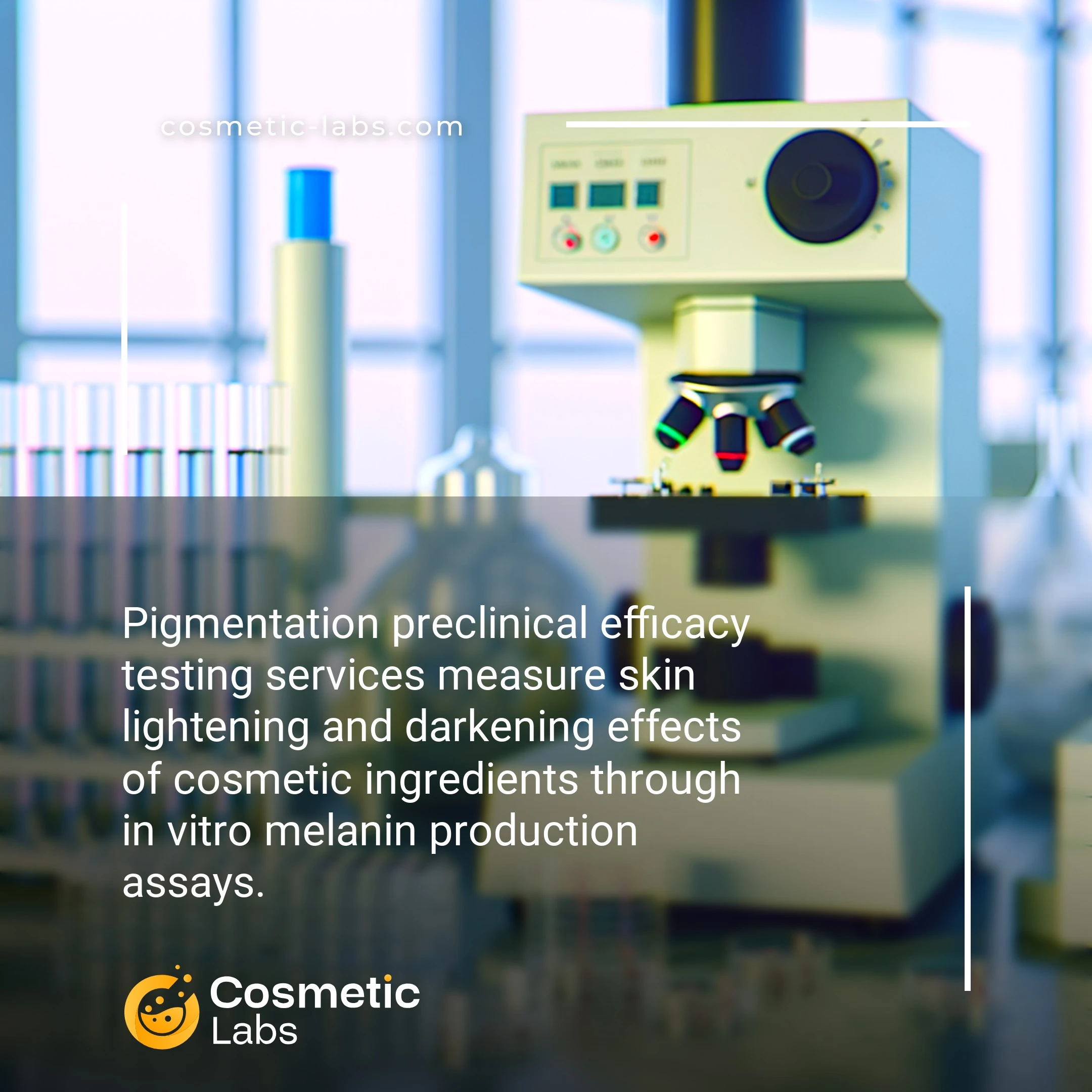Pigmentation Testing Services for Cosmetic Efficacy Studies

What is Pigmentation efficacy testing?
Pigmentation preclinical efficacy testing services evaluate how well cosmetic ingredients and formulations affect skin color, dark spots, and melanin production before human trials begin. Labs use in vitro assays and artificial skin models to measure tyrosinase inhibition, melanin synthesis reduction, and brightening effects. These tests help brands validate whitening claims, optimize ingredient concentrations, and identify promising formulations that warrant clinical studies.
Why do you need this service?
Brands use melanin inhibition assays to validate brightening claims before launching serums and spot treatments, while anti-aging formulations undergo tyrosinase activity testing to prove dark spot reduction. Our partner labs conduct these studies on ingredient concentrations and finished products, delivering quantifiable data for regulatory submissions and marketing claims within 4-6 weeks.
Who provides Pigmentation efficacy testing services?
All cosmetic labs providing Pigmentation efficacy testing services
There is no company providing these services at the moment.
Pigmentation Preclinical Efficacy Testing Services
Pigmentation preclinical efficacy testing validates your brightening, anti-aging, and skin tone products before market launch. Labs on our platform run controlled studies that measure melanin reduction, tyrosinase inhibition, and overall skin lightening performance using standardized protocols.
In Vitro Melanogenesis Assays
Labs test your formulations using cell culture models that replicate human melanocyte behavior. These assays measure tyrosinase activity and melanin synthesis inhibition at the cellular level. Testing typically takes 7-14 days and provides dose-response curves for active ingredients.
Key measurements include:
- Melanin content quantification
- Cell viability assessment
- IC50 values for active compounds
- Cytotoxicity screening
Results help you optimize concentrations and validate ingredient efficacy claims for regulatory submissions.
Ex Vivo Skin Model Testing
Advanced labs use reconstructed human epidermis models to test pigmentation modulation in tissue-like environments. These 3D models provide more realistic data than cell cultures alone. Testing protocols measure pigment distribution, melanin transfer, and barrier function changes over 21-day treatment periods.
Standard protocols evaluate:
- Topical application penetration
- Melanin density changes
- Inflammatory marker expression
- Skin barrier integrity
Connect with specialized labs on our platform to design custom pigmentation testing protocols that meet your specific product development needs and regulatory requirements.
11 subcategories of Pigmentation efficacy testing services
There are no results matching your search
Practical Applications of Pigmentation Preclinical Efficacy Testing
Pigmentation preclinical efficacy testing applications span from ingredient validation to product claim substantiation, enabling brands to develop targeted solutions for hyperpigmentation, melasma, and age spots.
Ingredient Screening and Formulation Development
Labs use melanin synthesis inhibition assays to evaluate raw materials like kojic acid, arbutin, and vitamin C derivatives before formulation. These cell-based models measure tyrosinase activity reduction and melanin content changes over 7-14 day exposure periods. Testing protocols include dose-response curves from 0.1% to 5% concentrations to establish optimal usage levels.
Formulation teams combine multiple active ingredients based on synergistic effects identified through preclinical screening. Labs test ingredient combinations using B16 melanoma cells or human melanocytes to predict real-world performance and avoid antagonistic interactions.
Product Claim Validation and Regulatory Support
Brands validate marketing claims through standardized efficacy protocols before product launch. Labs measure lightening effects using spectrophotometry and image analysis on reconstructed skin models or ex-vivo tissue samples. Testing generates quantifiable data showing percentage improvements in skin tone evenness and spot reduction.
Regulatory submissions require documented proof of efficacy claims. Preclinical data supports product registration in markets like EU and Asia-Pacific, where authorities demand scientific evidence for cosmetic claims. Labs provide detailed reports with statistical analysis and methodology documentation.
| Testing Method | Primary Application | Timeline | Key Metrics |
|---|---|---|---|
| Tyrosinase Inhibition Assay | Ingredient screening | 3-5 days | IC50 values, % inhibition |
| Melanin Content Analysis | Formulation testing | 7-14 days | Melanin reduction % |
| 3D Skin Model Testing | Product validation | 14-21 days | Lightening efficacy, safety |
| Ex-vivo Tissue Studies | Claim substantiation | 7-10 days | Penetration, activity |
Ready to validate your pigmentation products? Connect with experienced cosmetic labs on our platform to discuss your specific testing requirements and regulatory needs.

